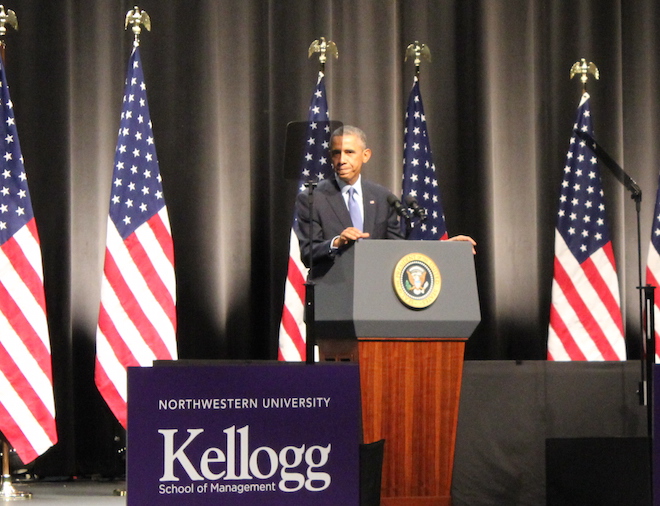Al Cubbage, the tall vice president of University Relations, has a son who was a theater lighting designer. Cubbage recounted what his son once told him: in theater, it’s always chaos until the curtain goes up.
For 10 days this fall, a manilla folder never left Cubbage’s hands. It contains a collection of notes that the University Archives is begging to acquire. The first note in that folder was penned on Sept. 22, when Cubbage first received word that President Barack Obama was planning to speak at Northwestern the following week.
“This is my presidential visit folder,” Cubbage said, pulling it from his desk. “I literally took this thing home with me, had that with me everywhere. So everything was very, very planned out.”
That President Obama would speak on the economy to mostly Kellogg School of Management students on Oct. 2 was meant to be a well-kept secret. The White House didn’t want to make anything official, in case something – like an international crisis – came up on the day of the speech. But that secret was revealed unceremoniously when students and Evanston residents noticed military aircrafts landing on the Lakefill a few days earlier in what the media speculated to be practice landings for the president’s arrival. It was the first time a sitting president has spoken on campus in 60 years.
The visit wasn’t random. Obama’s from Chicago; he taught at the University of Chicago Law School and served on the Illinois State Senate as well as represented the state in the U.S. Senate. And Northwestern President Morton Schapiro, along with Kellogg Dean Sally Blount, has long welcomed Obama to speak at Northwestern. The week prior to the speech, Schapiro received a call from The White House: the President would like to speak at Northwestern.
Northwestern had little over the week to prepare for the Leader of the Free World. A task force had to be created. Schapiro reached out to Nim Chinniah, Northwestern’s executive vice president, to oversee a working group to coordinate the event with White House staff.
The team Chinniah assembled was made up of 15 people, from departments like NUIT, Facilities Management, NUPD and more. Jake Julia, associate provost for academic initiatives, was one of those on the working group.
“Over the course of the next couple days, we did some preliminary planning,” Julia said. “Thinking of the venues, thinking of what issues might be addressed in advance of the presidential visit, and I would say a lot of preparation in the Tuesday through Friday afternoon timeframe.”
On Friday, Obama’s staff met with Schapiro and Chinniah to pick out a venue. The White House staff wanted something serious, suitable for a speech on the economy and preferably not too large. On the other hand, Northwestern wanted to seat as many audience members as possible. Out of Cahn Auditorium, Pick-Staiger Concert Hall, Owen L. Coon Forum and Welsh-Ryan Arena, the White House tentatively chose Cahn as the location where Obama would speak.
“It’s a 900-seat auditorium for this event, and we had 9,000 people who wanted to be here,” Cubbage said with a laugh. That decision was confirmed the following day.
Planning for a presidential visit requires more considerations than planning for most other speakers. The president travels with the press and with security. Bruce Lewis, associate vice president of public safety, had to coordinate with Evanston police and fire as well as with the Secret Service. Four rows of seats had to be removed from the center of Cahn to accommodate for the press, and a new, higher floor had to be built in the orchestra pit to accommodate for photographers.
And then there was the issue of the Kellogg signs.
“What we wanted right off the bat was to make it look as purple as possible, with as many Northwestern logos and Northwestern signs all over,” Cubbage explained. “But the White House understandably wanted to make sure that everyone knew that this was an important policy speech for the President.”
So after some negotiating, the White House and the University allowed for two signs each labeled with “Kellogg” and “Northwestern University” to be positioned adjacent to the podium on the floor. The signs were approved at around 9 a.m. on Oct. 1, and they had to be at Cahn by 5 p.m. that afternoon, one day before Obama’s speech.
They arrived at Cubbage’s office at 4:50 p.m.
“I physically carried those signs myself,” Cubbage recounted. “We weren’t going to trust them to a delivery service or anything like that. I actually carried them in my hands and delivered them physically to the White House and I said, ‘I am giving you possession of the signs.’”
Finally, the next morning, Obama spoke in Cahn Auditorium. He was viewed by Northwestern community members in the auditorium and throughout campus at university-coordinated viewing rooms. And after the speech, he quickly entered his motorcade, and was gone. The working committee decided to have a get-together the following week to celebrate the speech.
The show was over. When Cubbage recounts those 10 days leading up to the performance, he remembers what his son told him about working in theater. When the curtains go up, the chaos of the present turns into magic.
“We were really busy – I wouldn’t say chaotic – we were fully employed for the 10 days or whatever prior to the president coming,” Cubbage said. “But when he came out on the stage and started speaking and all that, it was magic. It was a lot of fun.”
